  
Kobolese Confederation;
High Nenomause Commonwealth;
Freng Mercantile Republic. | Olympic-Class
Colony Ship. | 
Clariont Flag Of The UGC. |
|---|
Ussually, colony ships are mere vessel, used to transport people and material to "a" place to be deposited, where they build the colony they're planning. The Olympic-Class bucked this trend, being the colony in and of itself.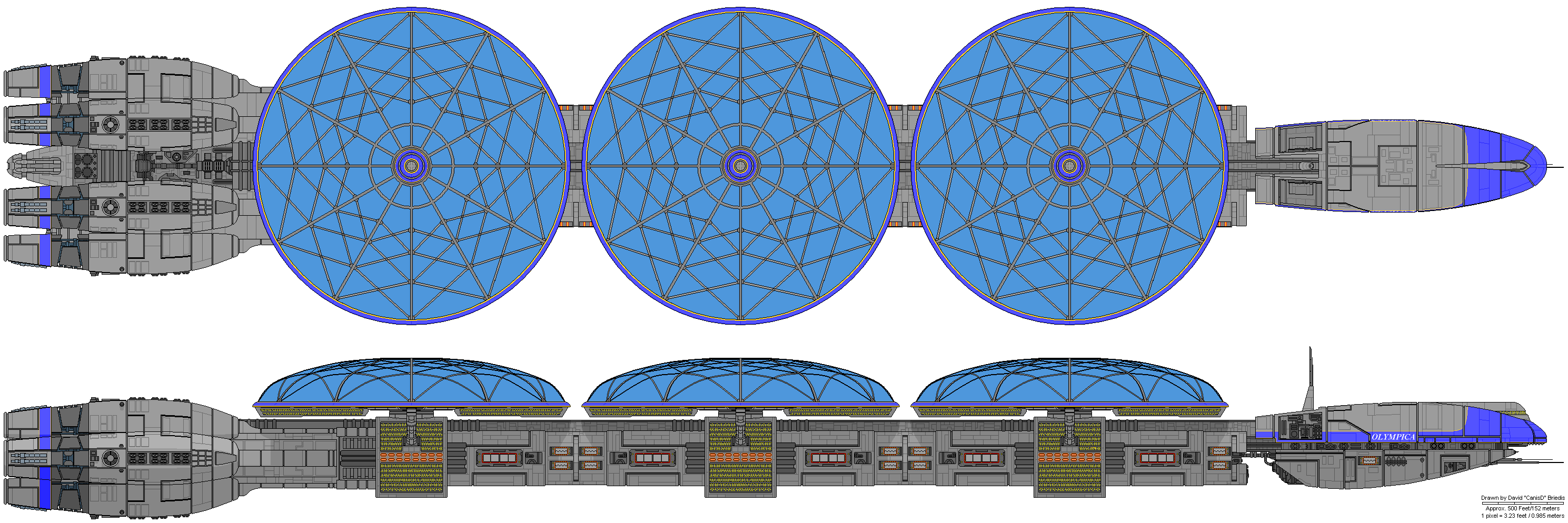 | | UGV Olympic Namesake Of The Class. |
|---|
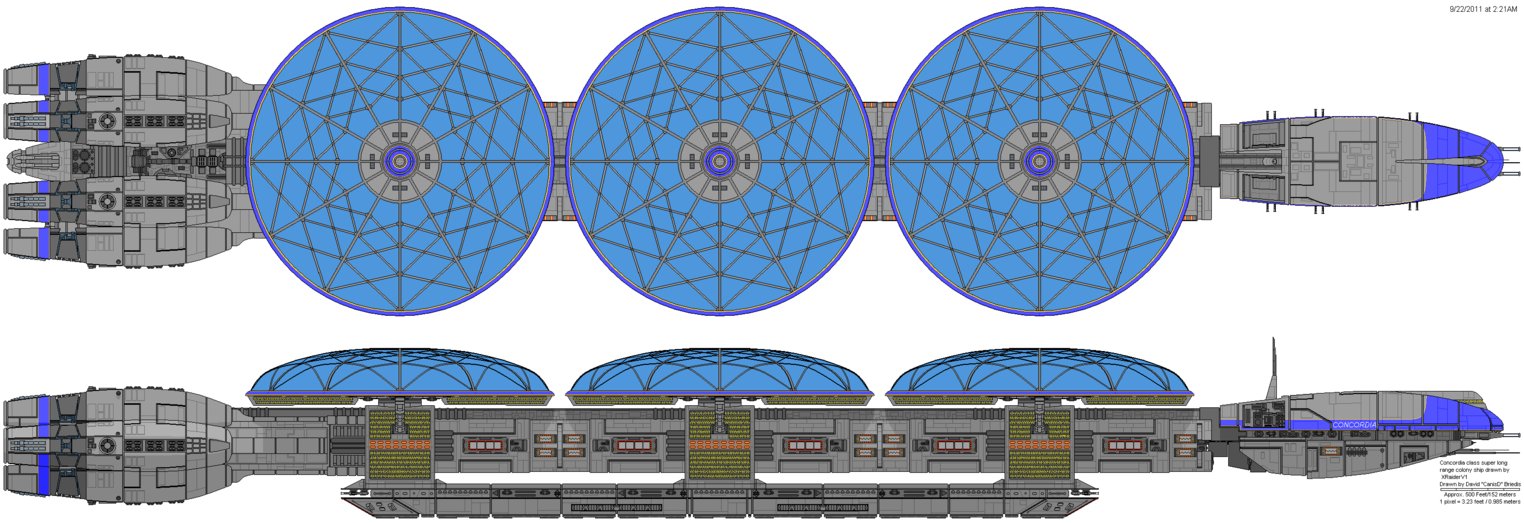 | | Concordia-Subclass. |
|---|
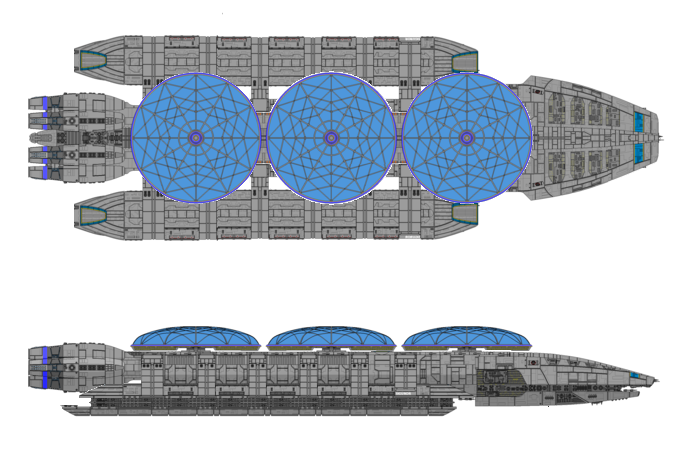 | | KEYSER-Subclass. |
|---|
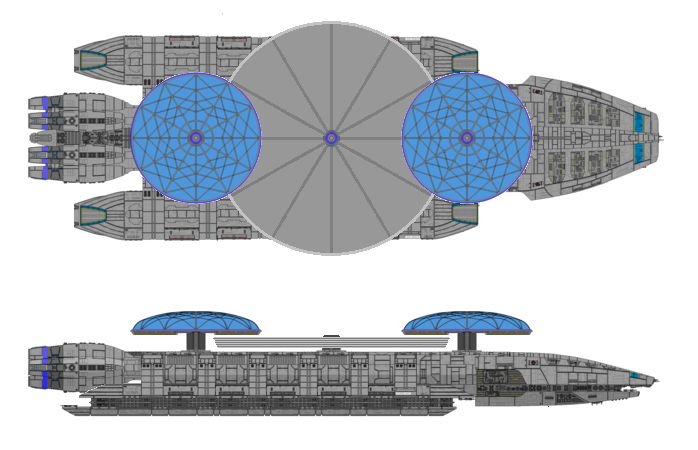 | | KEYSER-Subclass (industrial variant). |
|---|
Techniques derived from Kobolese ship design, most notably the large biodomes (of which only three are shown on this example), are generally use to grow foodstuffs, but can be detached as micro space stations in their own right; They can also be deposited on suitable bodies to serve as proto-cities, but this is the exception.The design is a collaborative of Kobolese, High Nenomause, and Freng technologies, producing a ship that can serve almost any non-militry purpose equally. An up-armed variant, the Concordia, and BATTLESTAR/Olympic hybrid (essentially an Olympic-Class with BATTLESTAR-Class flight pods), the KEYSER, were proposed but never developed to any significant degree.The Olympic-Class is also somewhat unique, in that they aren't intrinsically fixed-dimension; Each dome is 10 miles across, and the hulls can be built to accommodate as few as one or as many as 30 in three rows of 10 each (the current record holder is in fact 30, the Redding of the Jefferson Pack). Up to twice this length is possible according to engineers, but the Patrol put its foot down and categorically refused to certify a ship exceeding 10 dome length (they only agreed to this much if the domes were "wrapped" around the hull and with expanded emergency evacuation equipment and procedures). One additional main thruster is required to every 3 domes. (A theoretical domeless hull could easily survive on as little as 2 thrusters, though 6 would be normal for hull, and 8 is the number installed on a standard "3 by 1").Olympic-Class colonies tend to travel in "packs" of 10's, with 1 in 10 ships of the pack being militry-grade escort for protection. The flagship is usually "trimmed" with blue racing strips, but this is not always the case. Additionally, they tend to select a single system within which to operate for extended periods of time, dropping about twice their nominal number of domes into open space (mostly unmanned) to manufacture zero-gravity products (such as aluminium oxynitride [AlON] and clear solar panels used extensively aboard the ships themselves).The UGC gave extensive support to the development of the Olympic-Class in order to have access to the blueprints and development details; They even declared 10 shipyards "imminent domain" (to the consternation of the yard's owners). This was secretly in support of Project Galactique; The potential, if necessary, of having a full fleet of a single class of ships capable of evacuating 90% of society in relative comfort appealed greatly to the powers that be. (Conspiracy theorists routinely claim this is the case, and the Council neither confirms nor denies the claims, stating only that "all options remain on the table.")Surprisingly, to date none of these colonies has been a significant failure, though almost all have had various issues, ranging from benign to quite serious indeed; The Listareies had a major viral outbreak taking 30% of her residents before containment and treatment could begin, the Distanial had a main reactor breach that could easily have killed all aboard, but was successfully ejected (she was taken in tow by another ship in her pack). None have been evacuated permanently, and only one, the Jervaiset (pronounced jar-vi-see-ette), has been lost to deliberate action (pirate attack). (She was not abandoned- she was destroyed with the loss of all hands.) Even then, the Jervaiset is an anomaly of the first order, with all other such events being successfully defeated with typically minimal losses (though the domes are particularly fragile, and it's typical to have to repair sections of these and have a massive cleanup afterwards).Because the Olympic-Class was meant for long-duration habitation (being colony ships), they are typically armed in a manner consistent with their size and usage.Naming Conventions: Also somewhat unique amongst UGC vsls, the Olympic-Class has a globally mandated naming convention; Any given ship starts out as a colony of "a" planet, whatever planet that may be. That planet then has certain legal obligations relating to the ship, wherever she may be, and whatever her population index may be. The naming convention then follows that the first half of the name, always in BOLD BLOCK PRINT is the pack name, which usually is from a region, then the ship's one name In The Typical Case Italics. The aforementioned Redding's full name is JEFFERSON Redding, while Jervaiset was DERENNA Jervaiset (Garuda). The common practice is to refer to the ship only by her own name unless necessary, and by her name then Pack Name only when required. The planet and system are rarely mentioned, and the regional authority (state, province, etc.) never are, except in certain legal filings (even then, only when absolutely necessary). While it is against common practice, the Redding 'could' be referred to as "the JEFFERSON Redding of Terra," the Jervaiset as "the DERENNA Jervaiset Of Garuda," etc.As a nod to the Valley Forge-Class (from whence much of this class' deign comes from), the Olympic-Class is outfitted with 03 D-31 Series Drones per dome, and typically named Huey, Dewey, and Louey. However, the D-31 series isn't very remarkable, and spend most of their time seemingly aimlessly wandering around. (No one has yet realized, they're actually actively participating in the growing process in the domes where plants are grown; they take care of the plants as best they can with their limited capabilities.) WALL-E Series, VI.N.C.EN.T. Series, and Gonk Series drones make the majority of the the ship's drone compliment, though Centurions are commonly included (staying well out of sight), at least on Kobolese flagged ships of this class. MDD-03 Micro Drones are also plentiful, and often referred to as "duct rats" because they scour the ducting, piping, and other spaces that biologic hands simply can't reach, making repairs and looking for actual rats (or similar vermin). (GM's: See Short Stories). Exocomps are also used, but in smaller quantities, since they are considered "intelligent," where as the rest are not.Name: UGS Olympic-ClassModel Type:Colony Ship.Crew: For safe and effective operation, at least 50 are needed per done, plus around 100 more for Mechanical Plant and another 25 for Ship's Operations.Passengers: Rarely more than 100.MDC By Location: |
Hull-
Bridge-
Docking Bays (4)-
External Hatches- | 5,000
500
150 each
100 each | Agridomes (up to 50)-
Thrusters (10)-
Solar Panels (up to 20)-
Sensory Arrays (up to 05)- | 1,000 each
700 each
100 each
500 each |
| Speed and Statistical Data: |
Spacefold: Not Possible. They CAN survive spacefold, however.
FTL: Factor 2
Cruising Speed: Mach 10
In Atmosphere: Will Crash, doing 1D10 times 1,000 MD to the impact area in a blast radius of 100 miles, and 1D10 times 100 to the entire face of the planet.
Clearance: 200 feet
Beam: 200 feet
Length: 200,000 feet
Weight: 20 million tons without agripods; Each agripod has an additional 100 thousand tons, plus whatever is growing.
Cargo: 500 million tons. Mostly foodstuffs (a little ironic). | Power Systems:Primary: Solar Panels Range: 50 light years. Note: No combat can be sustained on solar panel alone.Secondary: MCC-221a Thermal Pile Reactors Lifespan: 20 years.Tertiary: Emergency Batteries (100,000) Lifespan: 100,000 hours on emergency power status.
Cost and Availability: 10 million credits, plus agripods (500,000 credits each); Always available.
Black Market: Not available; Even re-habed T'sentraedi warships are worth more. The REF couldn't even sell captured ones as warehouses, and would be forced to scrap them out. |
| Weapons Systems: |
1. Defensive Laser Batteries (10): A battery of defensive lasers dot the hulls of these vessels. Mostly for anti-missile and meteorite defense.
M.D.: 5D6 per blast.
Rate of Fire: Per gunners attacks per melee plus bonuses (generally 4 or 5 per melee).
Range: 500 feet.
Payload: Unlimited.
2. Ships, Fighters, Power Armor, and Robots:
Shuttles- Up to 02.
Mecha and Fighters-Normally none on a permanent basis, however, up to 20 can be accommodated, and these vessels are fully rated for re-fueling operations. A few outlier systems have converted one or two these vessels to Space Fighter and Guardian Fighter carriers. Though this is frowned upon by the REF, there is nothing they can really do about it.
| Optional Automated Weapons Systems: Used only on Automated Defense Platforms.
1. Laser Batteries (varies): Batteries of heavier lasers replace most of the normal defensive lasers; However, at least one defensive laser battery will be retained, plus one missile battery, so no more than 08 will be carried.
M.D.: 1D4 times 100 per blast.
Rate of Fire: Twice per melee.
Range: 200,000 miles.
Payload: Unlimited.
2. Automated Missile Battery: At least ONE of the normal defensive Laser batteries will be converted to a missile battery.
Missile Type: Any MRM or LRM.
Purpose: Anti-Ship Defense.
M.D. and Range: Varies by type used.
Rate of Fire: Twice per melee.
Payload: Up to 1,000.
3. Defensive Laser Batteries (10): At least one defensive laser battery will be retained for anti-missile and meteorite defense.
M.D.: 5D6 per blast.
Rate of Fire: Per gunners attacks per melee plus bonuses (generally 4 or 5 per melee).
Range: 500 feet.
Payload: Unlimited. |
| Station Statistics:As a space colony, the Olympic-Class also has the following:Size And Orientation:Small outpost (150)Medium Station (300)Large Station (400)City Size (500)Function: Industrial (+10 Power Systems, +10 Supplies). |
|
| A: Power System: | B: Defenses: | C: Sensors: | D: Communications: |
|---|
| Nuclear, Solar, and Battery Power (0) . | Shields (3₧ every 3,000 MDC); Point Defense Weapons Systems (5); Medium Weapons (20); Space Fighters (15₧/Squaron); Armored Hull; 20₧ 25%. | Satellites:Medium Range Satellites 4₧/6 Sats; Scouts (10); Superior Sensors (40). | Stellar Communications (40). |
E: Station Maintenance| F: Supplies: | G: Internal Security Personnel: | H: Medical Facilities: | |
|---|
| Top Priority (15; Can be upgraded as a pack at 15 ₧/ship). | Self-Sufficient (25); They do have to trade some, and trade outside the pack as a pack. | Private Security Force (20); Can be upgraded at 75% of the normal difference in ₧. | Full Hospital (75). |
| I: Environmental Systems: | J: Environmental Systems: | K: Independent Business: | L: Transients: |
|---|
| None (0); Minimal Security Measures (5); Medium Security Measures (10); Magic Security Measures (20); Maximum Security Measures (25); High-Tech Security Measures (50). | Advanced System (25); Can be upgraded to Super Advanced for 30 ₧. | Market Place (20); One ship in any given pack will be designated as "Big Business" to trade on behalf of the pack. | 10% (20); One ship in the pack will usually be a bit more "open" for allowing prospective new members in (as high as 40%), usually the one designated to trade on behalf of the pack. |
| Features: |
- ESM: Radar Detector. Passively detects other radars being operated.
- Radar: Combat grade radar. Range 100 miles, can track up to 50 individual targets. 95% reliability (00% against unfriendly stealthed vehicles).
- Blue Force Tracker: Identifies friend from foe. Overlays the information on both the radar and HUD, ensuring that friendly forces are not accidentally targeted.
- GPS: Standard tracking device. Ties into the Blue Force Tracker.
- HUD: Displays maps, radar, targeting information, and any OTHER information the wearer wants directly in front of the user.
- FLIR/SLIR: Forward and Side Looking Infrared. Allows pilot to get visuals on targets at night.
- Virtual Map: Displays a continuously-updating map of local terrain for the pilot. Takes data from and gives data to other friendly units in the area. Effective navigation of 85% as updates come. Good to 500 miles. Specific range can be adjusted in 1 mile increments.
| - Loudspeaker: Amplifies voice 1 to 100 times. 100' in normal crowds.
- Video Camera: Records from the HUD. 50 hours of recording available.
- Full range optic sensory suite: Infrared, ultra violet, Magnification, night sight, color filters, thermal imager. Range is about 200 miles for MOST sensors.
- Telescoping Arms: By way of a Canadarm. Maximum reach is 6 feet.
- Escape Spheres: Can hold up to 10 survivors for one week.
- Survival Pack: A pack of simpler emergency survival supplies: Pup tent, sleeping bag, black light, GPS, first aid kit (bandages, gauze, bandage tape, pads, antiseptic/analgesic), plasma torch (for small repairs and starting fires), repair kit (with MDC Repair Spray), sewing kit (a small spool of thread and 5 needles),
7 star flares (250' apogee), 2 white parachute flares (1,500' apogee), 100' of black or brown parachute cord (150 lbs tensile strength), 2-5 days rations, 2 gallons water, water purification kit-good for about 10 gallons.
|
Up-Armed OLYMPIC-Class Combat Vessels:- Some systems have up-armed their Olympic-Class ships to serve as picket ships. The UGC officially frowns on this practice, but if they system fully owns the ship there is nothing they can do about it. These ship are rarely rigged for automated operations (though the batteries are rigged for remote operation with the crew at the bridge). The bridge is usually a smaller ship grafted in to serves as a life pod.
- Alterations: The alterations vary widely, but 'usually' the agripods are removed in favor of pods specially designed to support space fighters; Often these are automated or unmanned. Additionally missiles launchers and laser batteries are added.
| 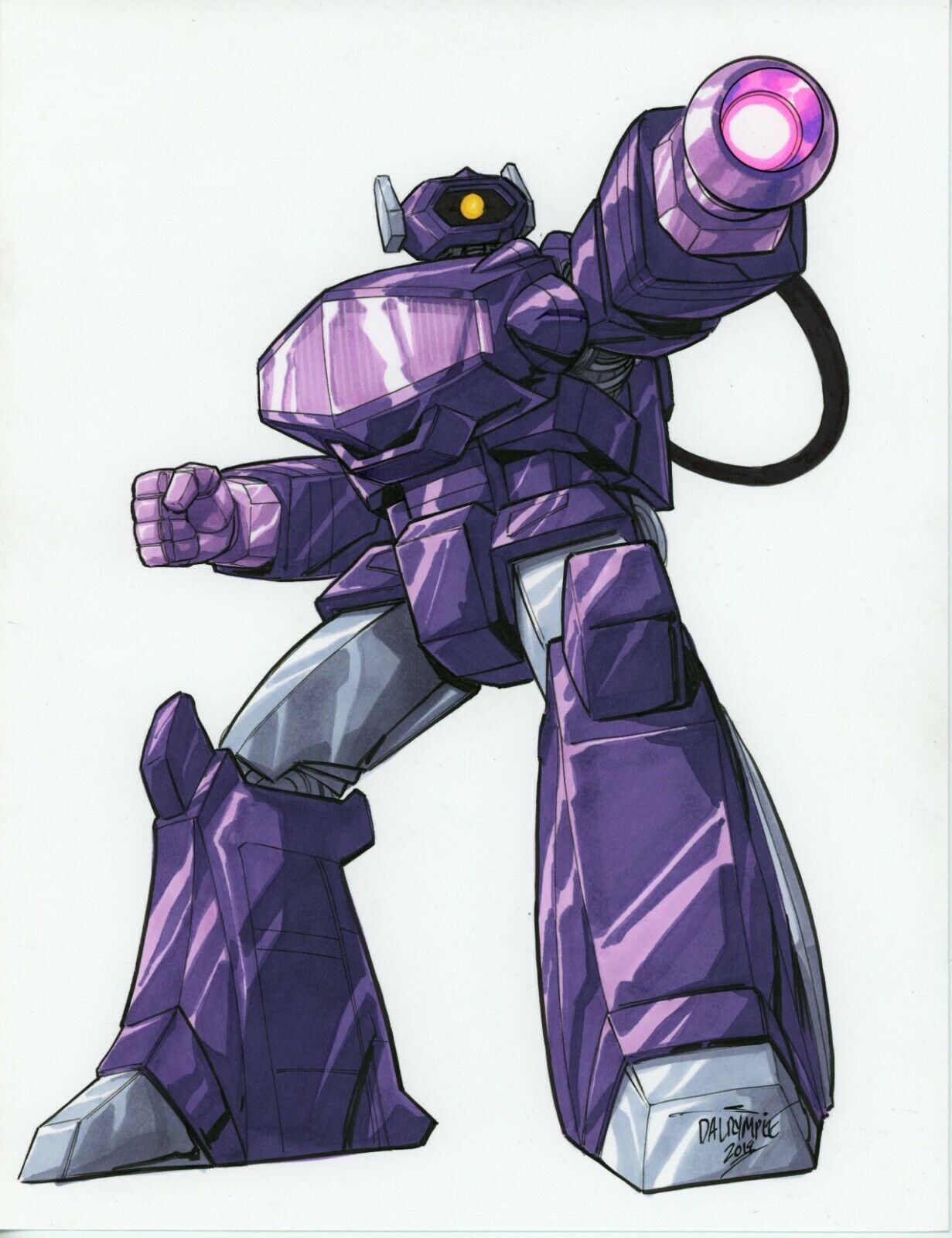 |
An MDD-03 Micro Drones of ALDERAAN Hallyn of Neo Alderaan;
Governor: Scott DALYMPLE. |
|---|
| Combat Bonuses from UGS Valley Forge-Class Combat Elite:1 additional attack per melee.One additional Attack Per melee at levels 3, 6, and 9 with any additional bonuses for the pilot.+4 Initiative.+5 entangle/snare/grab, Parry, Dodge, and Roll.+5 dodge. |










